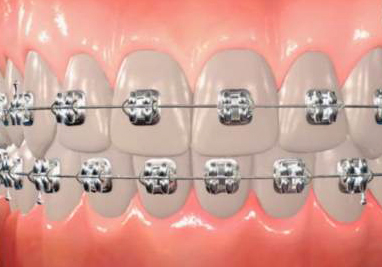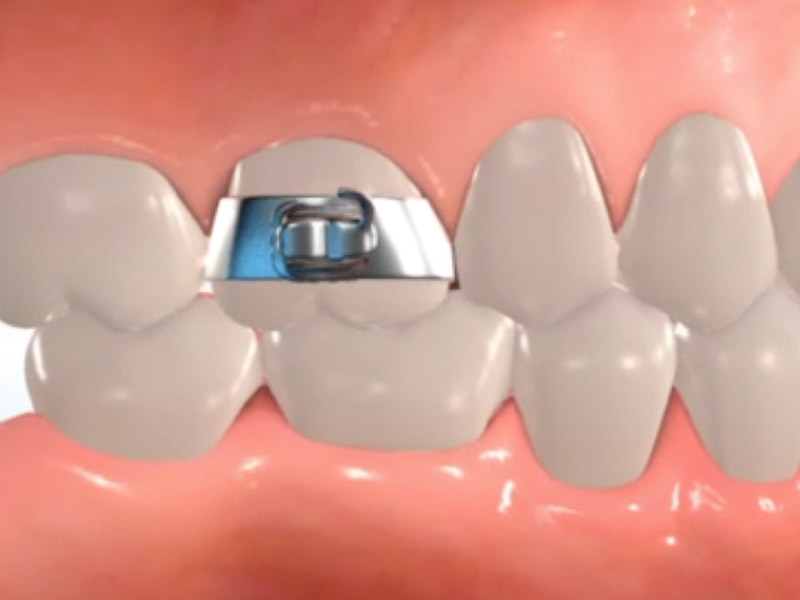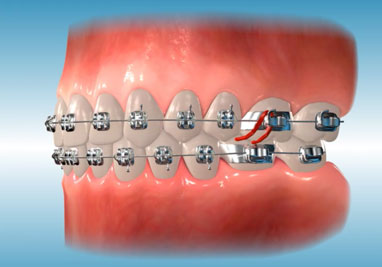







A metal wire which is attached to your brackets to move your teeth.

Bands are a ring of metal, which fit around the molars and sometimes premolars. The bands are selected from a range of sizes in order to find the tightest fitting band. The bands are sealed in position using dental cement that contains fluoride to prevent any decalcification during treatment.

A Biteplate is a removable appliance similar to a retainer that is used to correct a deepbite or to help correct a crossbite.

Brackets are the small metal or ceramic modules attached to each tooth. They serve as guides to move the teeth and hold the archwire in place.

A small metal part that is welded on the outside of a molar band. The molar band contains slots to hold archwires, lip bumpers, facebows and other things your orthodontist uses to move your teeth.

A stretchable plastic chain used to hold archwires into brackets and to move teeth.

Elastics or rubber bands for braces help move the upper and lower teeth relative to each other, ultimately achieving a better bite. The orthodontic rubber bands are typically effective for correcting overbites, underbites, or other types of alignments of the jaw. They are also useful for moving a tooth out of alignment or to close a space in the mouth.

The Bonded Upper Expander is constructed with a palatal expansion screw whose metal arms are soldered to wire framework. The framework encircles all of the posterior teeth and supports the acrylic posterior bite plane. The Bonded Upper Expander is a way to widen a narrow upper jaw.
Fixed retainers consist of a metal wire bonded to the back of the teeth. Fixed retainers can stay in place indefinitely.

The Forsus appliance is an orthodontic appliance that is affixed to the teeth. Springs mounted on the side of the appliance force the lower jaw forward upon closure of the jaws retraining the bite and correcting a Class II problem.

Invisalign® is a series of clear, removable teeth aligners that both orthodontists and dentists use as an alternative to traditional metal dental braces.

A lingual arch is an orthodontic device which connects two molars in the upper or lower dental arch.

A device that is used to protect your mouth from injury when you are participating in sports. The use of a mouth guard is especially important for orthodontic patients, to prevent injuries.

The Nance button is utilized to hold teeth in position to allow for the movement of other teeth. The impact of the button on the lower palate creates force on the back molars.

A palatal expander, also known as a rapid palatal expander, rapid maxillary expansion appliance, palate expander or orthodontic expander, is used to widen the upper jaw so that the bottom and upper teeth will fit together better.

The Quad Helix is checked and expanded approximately once every six to eight weeks. After the expansion is complete, the Quad Helix will remain in the mouth until the expansion is stable. Patients may feel mild discomfort for a couple of days. The tongue and cheeks have to make adjustments to the new appliance. Speaking and eating will require patience and time getting used to your appliance. Avoid hard foods and sticky foods. You will be able to clean your teeth and Quad Helix with your regular toothbrush.

A gadget that the orthodontist gives you to wear after your braces are removed. The retainer attaches to your upper and / or lower teeth and holds them in the correct position while your jaw hardens and your teeth get strongly attached to your jaw. At first, you wear the retainer 24 hours a day, and then only at night.

The Schwarz Appliance is a functional appliance used to expand the upper dental arch by stimulating growth of the bone's width. Once widened, the suture knits together. The Schwarz Appliance is prescribed only prior to completion of growth. It is adjusted daily as instructed, until the palate has been widened enough. It is then left in place for about four months without further adjustment while the bone fills the center palatal suture and healing occurs.

Separators are tiny rubber bands or springs that your orthodontist places between your back teeth. These separators prepare your mouth for braces by creating a small gap between these teeth. This space allows for the placement of a metal band around your molar, which anchors your braces in your mouth.

An appliance that can be used on both arches for minor rotation and correction of anterior alignment.

This simple device is given to address severe thumb/finger sucking habit. It involves using a fixed wire crib attached to two back braces.

The Transpalatal Bar (TPA) is a fixed appliance that is attached to bands on the upper molar teeth. The bar that sits across the roof of the palate fits into a soldered clip located on the bands.
